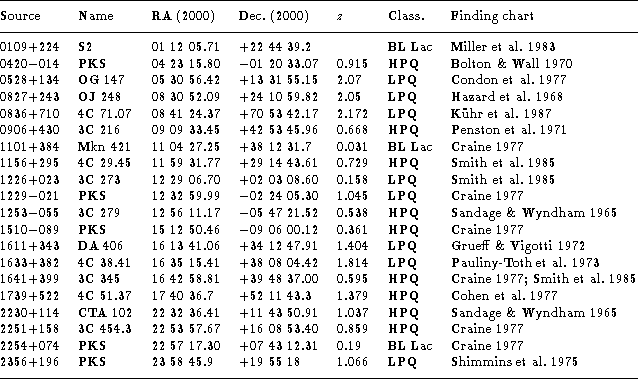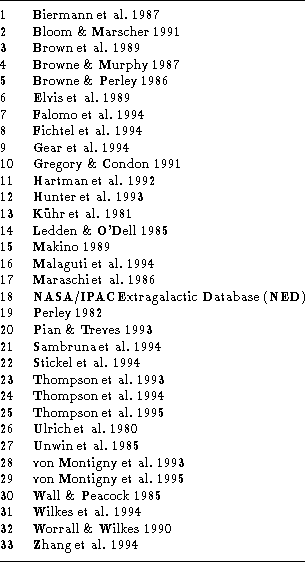
Table 1: List of the monitored blazars

Table 1: List of the monitored blazars

Table 2: Emission properties of the monitored blazars
The blazar optical monitoring program was started at the Torino Observatory in
November 1994. The data have been obtained with the ![]() Cassegrain
REOSC telescope equipped with a
Cassegrain
REOSC telescope equipped with a ![]() pixels charge-coupled device
(CCD) camera. The scale of the CCD is
pixels charge-coupled device
(CCD) camera. The scale of the CCD is ![]() per pixel. In order to
collect images of as large a number of sources per night as possible while
preserving some spectral information, we initially chose to observe in the R
(Cousins) and B (Johnson) bands only. More recently we have decided to
observe in the V (Johnson) band too in order to get a more complete spectral
picture and to make our data more easily comparable with those of other
astronomers. Exposure times in the R band range from
per pixel. In order to
collect images of as large a number of sources per night as possible while
preserving some spectral information, we initially chose to observe in the R
(Cousins) and B (Johnson) bands only. More recently we have decided to
observe in the V (Johnson) band too in order to get a more complete spectral
picture and to make our data more easily comparable with those of other
astronomers. Exposure times in the R band range from ![]() for the
brightest objects (like Mkn 421 and 3C 273) to
for the
brightest objects (like Mkn 421 and 3C 273) to ![]() for the faintest
ones (e.g. PKS 0528+134). Flat field frames are taken against the sky both at
sunset and at dawn, when possible; each time three or four frames per filter
are made and then the median is calculated for the images correction. The bias
level is checked several times along the night and then subtracted from the
images. No dark current correction is necessary.
for the faintest
ones (e.g. PKS 0528+134). Flat field frames are taken against the sky both at
sunset and at dawn, when possible; each time three or four frames per filter
are made and then the median is calculated for the images correction. The bias
level is checked several times along the night and then subtracted from the
images. No dark current correction is necessary.
The data reduction is performed with a mixture of the MIDAS and Robin procedures. This latter was developed at the Torino Observatory by L. Lanteri: the point spread function is fitted by means of a circular gaussian, the background being subtracted by fitting it with an inclined plane. This method has proved to be faster than the MIDAS integrated aperture photometry and to give stabler results.
The blazars magnitude and corresponding uncertainty are derived by comparison
with 3-4 reference stars in the source frame. If available, we have chosen
stars included in already published photometric sequences, evaluating again,
when possible, their magnitudes through the observation of Landolt's fields
(Landolt 1992) and adopting our own calibration. This was performed with the
SNOPY general purpose photometric reduction program contained inside the MIDAS
software package. The maximum error allowed in the passage from the
instrumental to the standard magnitudes is ![]() .
.
When photometric sequences in the literature were missing, we chose reference stars of various magnitudes. In this way the brightest two objects usually allow to calculate the source magnitude with a minimum error, while stars of brightness comparable with that of the source can be used to obtain reliable error estimates (see Sect. 3). In several cases (0109+224, 0420-014, 0528+134, 1101+384, 1641+399, 1739+522, 2230+114, 2251+158, 2254+074, 2356+196) we could neither calibrate the reference stars nor find photometric sequences in the literature, so that we shall present the data as magnitude differences with respect to the minimum magnitude registered during the observational period.
In Table 1 (click here) the list of the monitored objects is presented, including their identification features (name, right ascension and declination, redshift, classification, and reference for the finding chart).
Table 2 (click here) gives information on the source emission properties at different
wavelengths: in Cols. 2-4 published radio (![]() ), X-ray
(
), X-ray
(![]() ), and
), and ![]() -ray (
-ray (![]() ) fluxes are
indicated; Cols.
5 and 6 show the minimum and maximum magnitudes in the R and, when available,
in the B band derived from our data (or the maximum variations
) fluxes are
indicated; Cols.
5 and 6 show the minimum and maximum magnitudes in the R and, when available,
in the B band derived from our data (or the maximum variations ![]() and
and
![]() in case of no calibration); in Col. 7 the absorption coefficient
in the V band is reported; finally, Col. 8 gives a list of reference
numbers for the bibliography (see Table 3 (click here)) relative to the quoted fluxes and
in case of no calibration); in Col. 7 the absorption coefficient
in the V band is reported; finally, Col. 8 gives a list of reference
numbers for the bibliography (see Table 3 (click here)) relative to the quoted fluxes and
![]() .
.

Table 3: References for Table 2